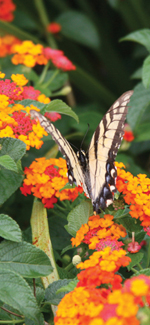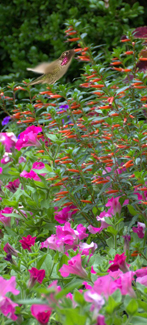Landscape Professionals - Gardening for Pollinators
Designing, planting and maintaining landscapes for ecologically-minded customers requires a shift in the way we think about and care for gardens. Plants play a huge roll in providing pollen, nectar and seeds for bees, butterflies, hummingbirds, songbirds and insects. Learn more about gardening for pollinators here.




Designing, planting and maintaining landscapes for ecologically-minded customers requires a shift in the way we think about and care for gardens. Flowers are planted not only for their beautiful colors, but also for their pollen and nectar which supports pollinator populations. Seed heads are left standing to offer nutrition to birds and beneficial insects. Holes in leaves from hungry monarch caterpillars are met with smiles rather than pesticides.
More than ever before, questions about planting for pollinators are coming in rapid fire from home gardeners who want to garden responsibly. They continue to desire to have a colorful landscape all season long, but now are asking themselves before they plant, Are these flowers bee-friendly? Will they feed the butterflies and hummingbirds that I want to see more of in my garden? And before they reach for an insecticide or herbicide, they are asking themselves, Is there a safer natural alternative that won’t harm the bees or add chemicals to my soil?
Surely, you have experienced this shift firsthand over the last few years in at least some of your clientele. There will always be that guy who wants to have the greenest lawn on the block and will do anything it takes to achieve it. But more and more, homeowners are making a shift in their lifestyle to more natural products, methods and practices. Buying organic produce at the farmer’s market has taught them that it’s ok if fruit and vegetables have small imperfections as long as they are healthier than non-organic alternatives.
The same principle carries through to the garden. Before you reach for an insecticide to treat your client’s plants at the first sign of insect damage, have a conversation with them about what is an acceptable level of damage. Talk about alternatives to chemicals, such as bringing in beneficial insects and swapping older plants out for more pest and disease resistant varieties. You might be surprised to find their answer is different today than when you had that same conversation five years ago.
Here’s an example of a commonly asked question you could add to your business’ literature:
What can I do to protect bees and other pollinators in my own yard and garden?
People who want to help protect pollinators in their gardens should avoid spraying open flowers with any insecticide with the exception of B.t. (Bacillus thuringiensis) which is a naturally occurring soil bacteria. Horticultural oil and insecticidal soap can also be used on cool mornings (< 50° F), after sunset, or at any time that bees are not present because the spray residue is not toxic to bees. Soap and oil can cause some plant injury, especially to open flowers. Plants that need to be protected against damaging insects by using a conventional insecticide should be sprayed after the plant is done blooming or after removing the flowers.
Gardeners consistently seek out flowers and plants that attract butterflies and hummingbirds to their gardens. Here are a few resources about Proven Winners plants that attract pollinators for both you and your clients to pursue further:
- Article: Attracting hummingbirds to your garden
- Article: Shrubs that attract birds
- Article: Attracting butterflies
- Pinterest: Gardens for Birds
- YouTube: Shrubs that Attract Wildlife




